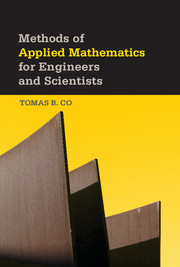Book contents
- Frontmatter
- Contents
- Preface
- I MATRIX THEORY
- III VECTORS AND TENSORS
- III ORDINARY DIFFERENTIAL EQUATIONS
- IV PARTIAL DIFFERENTIAL EQUATIONS
- A Additional Details and Fortification for Chapter 1
- B Additional Details and Fortification for Chapter 2
- C Additional Details and Fortification for Chapter 3
- D Additional Details and Fortification for Chapter 4
- E Additional Details and Fortification for Chapter 5
- F Additional Details and Fortification for Chapter 6
- G Additional Details and Fortification for Chapter 7
- H Additional Details and Fortification for Chapter 8
- I Additional Details and Fortification for Chapter 9
- J Additional Details and Fortification for Chapter 10
- K Additional Details and Fortification for Chapter 11
- L Additional Details and Fortification for Chapter 12
- M Additional Details and Fortification for Chapter 13
- N Additional Details and Fortification for Chapter 14
- Bibliography
- Index
IV - PARTIAL DIFFERENTIAL EQUATIONS
Published online by Cambridge University Press: 05 April 2013
- Frontmatter
- Contents
- Preface
- I MATRIX THEORY
- III VECTORS AND TENSORS
- III ORDINARY DIFFERENTIAL EQUATIONS
- IV PARTIAL DIFFERENTIAL EQUATIONS
- A Additional Details and Fortification for Chapter 1
- B Additional Details and Fortification for Chapter 2
- C Additional Details and Fortification for Chapter 3
- D Additional Details and Fortification for Chapter 4
- E Additional Details and Fortification for Chapter 5
- F Additional Details and Fortification for Chapter 6
- G Additional Details and Fortification for Chapter 7
- H Additional Details and Fortification for Chapter 8
- I Additional Details and Fortification for Chapter 9
- J Additional Details and Fortification for Chapter 10
- K Additional Details and Fortification for Chapter 11
- L Additional Details and Fortification for Chapter 12
- M Additional Details and Fortification for Chapter 13
- N Additional Details and Fortification for Chapter 14
- Bibliography
- Index
Summary
This part of the book focuses on partial differential equations (PDEs), including the solution, both analytical and numerical methods, and some classification methods. Because the general topic of PDEs is very large, we have chosen to cover only some general methods mainly applicable to linear PDEs, with the exception of nonlinear first-order PDEs.
In Chapter 10, we focus on the solution of first-order PDEs, including the method of characteristics and Lagrange-Charpit methods. The second half of the chapter is devoted to classification of high-order PDEs, based on the factorization of the principal parts to determine whether the equations are hyperbolic, parabolic, or elliptic.
In Chapter 11, we discuss the analytical solutions of linear PDEs. We begin with reducible PDEs that allow for the method of separation of variables. To satisfy various types of initial and boundary conditions, Sturm-Liouville equations are used to obtain orthogonal functions. The techniques can then be extended to the case of nonhomogenous PDEs and nonhomogeneous boundary conditions based on eigenfunction expansions.
In Chapter 12, we discuss integral transform methods such as Fourier and Laplace transforms methods. For the Fourier transforms, we cover the important concepts of the classic transforms, including the use of distribution theory and tempered distributions to find the generalized Fourier transforms of step functions, sine, and cosine functions. A brief but substantial introduction to distribution theory is included in the appendix. For numerical implementation purposes, we have also included a discussion of the fast Fourier transform in the appendix.
Information
- Type
- Chapter
- Information
- Methods of Applied Mathematics for Engineers and Scientists , pp. 377 - 378Publisher: Cambridge University PressPrint publication year: 2013
